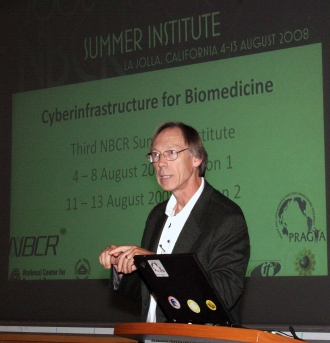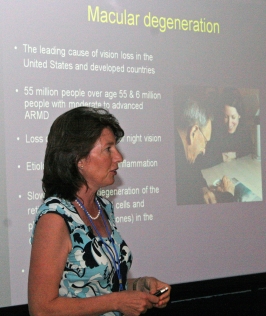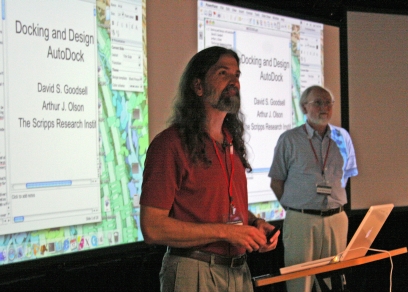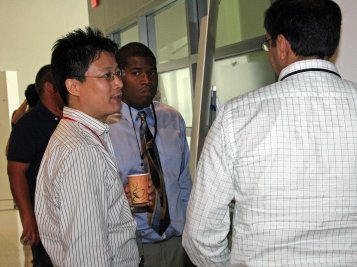NBCR's Summer Institute Provides Essential Training to Biomedical Researchers
|
San Diego, CA, August 21, 2008 -- More than 100 researchers from around the world participated in the National Biomedical Computation Resource's (NBCR's) third annual Summer Institute. This successful program provides hands-on training with tools essential for cutting-edge biomedical research and development. This year's focus was "Cyberinfrastructure for Biomedicine."
"This year we focused on research targeting infectious diseases such as HIV, AIDS and avian flu, as well as research in autism," said Wilfred Li, co-organizer of the Summer Institute, "and cardiac diseases, such as heart failure, heart attacks, strokes and sudden death." Li is the executive director of the NBCR.
Summer Institute 2008 provided hands-on training with a wide range of cutting-edge tools that enable multiscale modeling and visualization for research in these areas. It also presented an overview of the state-of-the-art and understanding of the role of cyberinfrastructure in biomedical research.
The 10-day program began on August 4, with a day-long mini-symposium focusing on "Multiscale Visualization and Modeling" in the morning and "Computer Aided Drug Design for Infectious Diseases" in the afternoon.
|
"We are delighted to have had such strong presenters participating in the mini-symposia," noted Peter Arzberger, the director of NBCR, "experts across many fields presenting the state-of-the-art in areas of interest to, as well as on the myriad applications of tools developed by, NBCR and in collaborating resources." Arzberger is a long-time Calit2 affiliate and co-organizer of the Summer Institute.
Topics covered in the mini-symposia included tools and visualization for model building, simulation suites (in particular those most suited to the study of infectious and other diseases and cardiac modeling) and flexible cyberinfrastructure upon which predictive modeling and simulation can be performed.
"The mini-symposium was the highlight event," said attendee Alark Joshi, a postdoctoral researcher at Yale University, "it showcased some amazing research findings. The best part of the Summer Institute was the interdisciplinary nature of the conference."
A second half-day mini-symposium was held this year (on the second Monday of the program, August 11). Chaired by Andrew McCulloch, a core leader with NBCR, the session focused on cardiac modeling and related issues. "Our invited speakers were very inspiring and relevant," said McCulloch, who is a professor and the chair of UCSD's Department of Bioengineering.
|
The mini-symposia were followed by hands-on training sessions organized into six tracks scheduled in a parallel system of morning and afternoon sessions, such that each participant could take two tracks. The six track topics were Cluster/Grid Computing & Workflow Management, Programming Scalable Scientific Applications, Virtual Screening & Computer Aided Drug Design, Computational Cardiac Electrophysiology and Mechanics, Molecular Electrostatics and Diffusion and Multiscale Imaging Analysis and Visualization.
"This year´s Summer Institute was our biggest and most successful yet," noted NBCR's McCulloch, "We had a large and enthusiastic group of students with a broad range of interests in cardiovascular medicine, including arrhythmia, ischemic heart disease, echocardiography and cardiac magnetic resonance imaging. The help of project scientist Roy Kerckhoffs, my graduate student Stuart Campbell and our lead programmer Fred Lionetti was critical to the success of the course."
One of the keys to the success of the Summer Institute is the hands-on training with cutting-edge tools from the authors of those tools.
"In my opinion the strongest thing about the NBCR summer school is that you get to know state-of-the-art programs directly from the authors and not from some impersonal tutorial from the web," said Christian Kramer, a graduate student from the University of Erlangen-Nuremberg, Germany, "It is much easier to come up with questions and also benefit from other peoples questions and tips from the authors."
|
"I'm interested in AutoDock, it was the most important reason to come" noted Tetyana Petrova, a graduate student in chemistry from Jackson State University, Mississippi, "I'm very glad I came; I found just what I was looking for."
The instructors and tool authors are also pleased with the format. Ruth Huey is one of the developers of AutoDock and has been an instructor for all three years of the Summer Institute. "I find it exciting to talk to people who are using and interested in our program and tools," she said, "It's one thing to see the numbers and the papers of researchers who are using our tools, but to see their faces and get their feedback, it's awesome." Huey is a researcher at The Scripps Research Institute (TSRI), working primarily on the development of the graphical user interface for AutoDock.
Zeyun Yu, an instructor the last two years agrees. "It's very fun. It's good for students, they have an opportunity to learn what we are doing now here at UCSD," he said, "and it's important for us to learn from students. The students ask questions that help us improve our code and tools. It's very good for both of us." Yu is a postdoctoral researcher in UCSD's math department. He taught sessions on tools and methods in mesh generation and image processing which help build spatially realistic models.
"We are pleased that we have software that is of value to the community. We use the Summer Institute not only to convey how to use tools, both our own and others, but also to develop new collaborations for our resource," explained NBCR's Arzberger, "Ultimately, we are looking to establish a strong community of researchers able to leverage these and other IT tools to conduct their research." Arzberger is also the chair of the PRAGMA Steering Committee (PRAGMA is the Pacific Rim Application and Grid Middleware Assembly).
|
"I also enjoyed the social aspect of the summer school, meeting other people from different parts of the world who work on similar problems," pointed out University of Erlangen's Kramer, "In contrast to other conferences, there are fewer people here and there is plenty of time to talk to each other in the evenings, so there is enough time and space to get ideas and discuss them." Kramer made a 23-hour trek to Summer Institute 2008, changing planes twice, from Erlangen, finding it "worth the effort."
Attendees came from 23 different institutions, 13 states, four countries, and one from a private, commercial company.
"The Summer Institute, in particular and NBCR in general, have given us opportunities to reach out to a large community of users and interact with them, as well as other instructors," summed up TRSI's Huey, "There are so many different research targets and different backgrounds of researchers attending, all using our tools in many ways."
By enabling biomedical, translational and clinical research to take advantage of the continued exponential increases in the capacities of computing speed, data storage, networking bandwidth, quickly improving tools and more broadly, in the advances in cyberinfrastructure, the NBCR is progressing towards a goal of personalized medicine through collaborative advances in cyberinfrastructure.
Related Links
NBCR Summer Institute 2008
Summer Institute 2008 Program
National Biomedical Computation Resource (NBCR)
Pacific Rim Applications and Grid Middleware Assembly (PRAGMA)





